Medieval Overexploitation of Peat Triggered Large-Scale Drowning and Permanent Land Loss in Coastal North Frisia (Wadden Sea Region, Germany)
Abstract
1. Introduction
- Storm frequency and intensity. Palaeoclimate reconstructions for NW Europe imply an increased storminess during the Medieval Warm Period/Medieval Climate Anomaly (MWP, beginning c. 950–1350 AD, e.g., [21,28,29,30,31,32]) and point to less frequent but more intense storms at the transition to and beginning of the Little Ice Age (LIA, c. 1400–1850 AD, e.g., [16,29,32]).
- Coastal protection. The human-made reduction in flooding space caused by large-scale dike building significantly increased water levels during high tide and storm surges [8,11]. At the same time, early dikes were still low and their maintenance often insufficient due to socio-political conflicts or epidemics [38,39,40,41,42], all together considerably increasing the risk of dike breaches and catastrophic effects of storm surges.
- Land reclamation. Draining of marsh- and fenlands initiated a self-enhancing downward spiral of sediment compaction and/or oxidation of peat, subsidence, and thus lowering of the already low-lying ground surface [8,9,41,43]. Large-scale peat extraction for melioration, heating and salt production further enhanced this process [44,45,46].
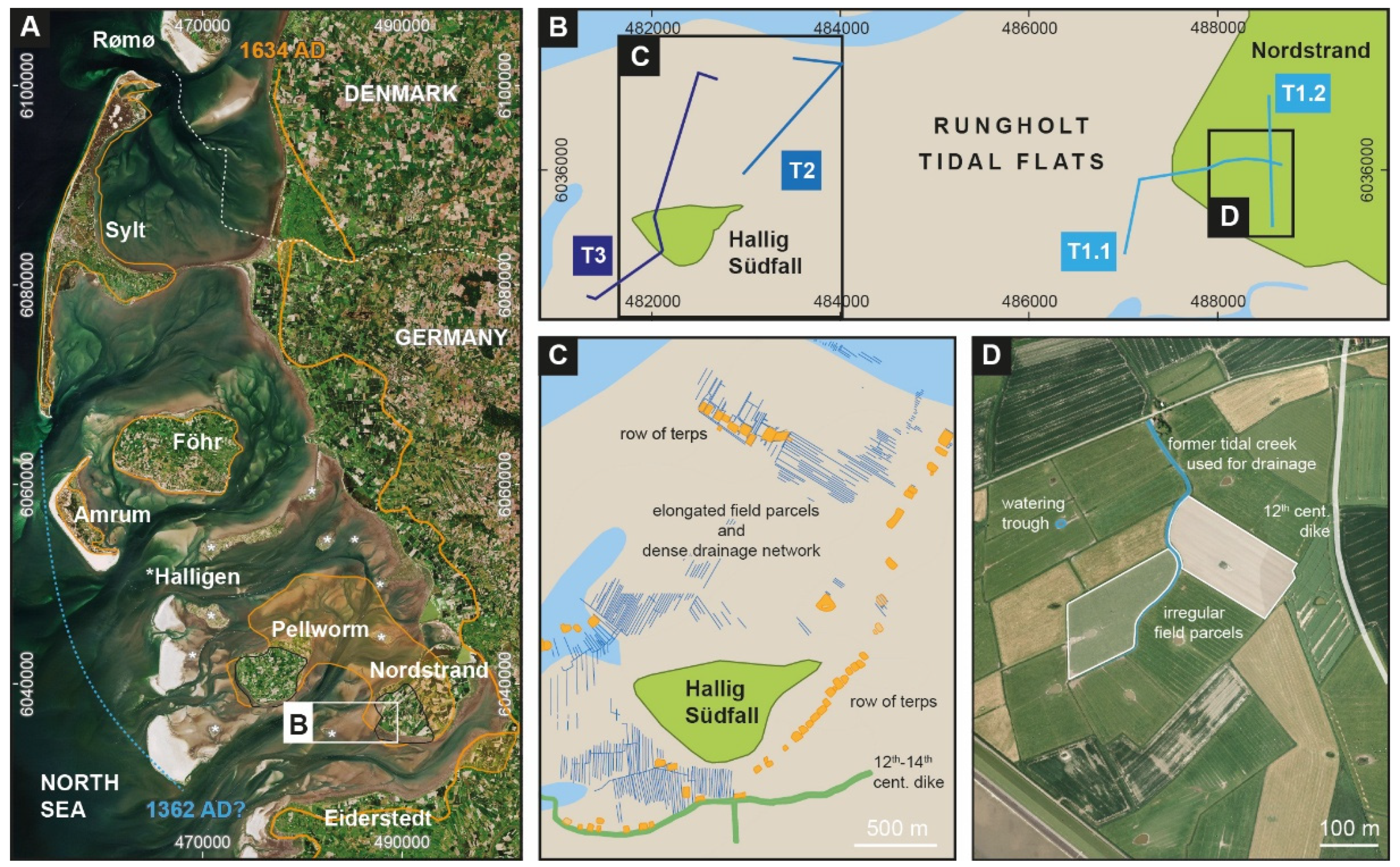
- Reconstruct the coastal landscape development of North Frisia prior to land reclamation based on sedimentological and geomorphological data and identify natural conditions and resources met by medieval Frisian settlers;
- Decipher medieval human impact in terms of cultivation measures and use of resources;
- Evaluate the effects and consequences of medieval human–environment interactions with respect to coastal vulnerability and the major/drastic coastal changes induced by the 1362 AD storm event.
2. ‘Type Case’ Approach
3. Materials and Methods
3.1. Geophysical and Archaeological Prospection
3.2. Coring and Trenching
3.3. Sedimentary, Geochemical and Microfaunal Palaeoenvironmental Parameter (PEP) Analyses
3.4. Dating Approach
4. Results
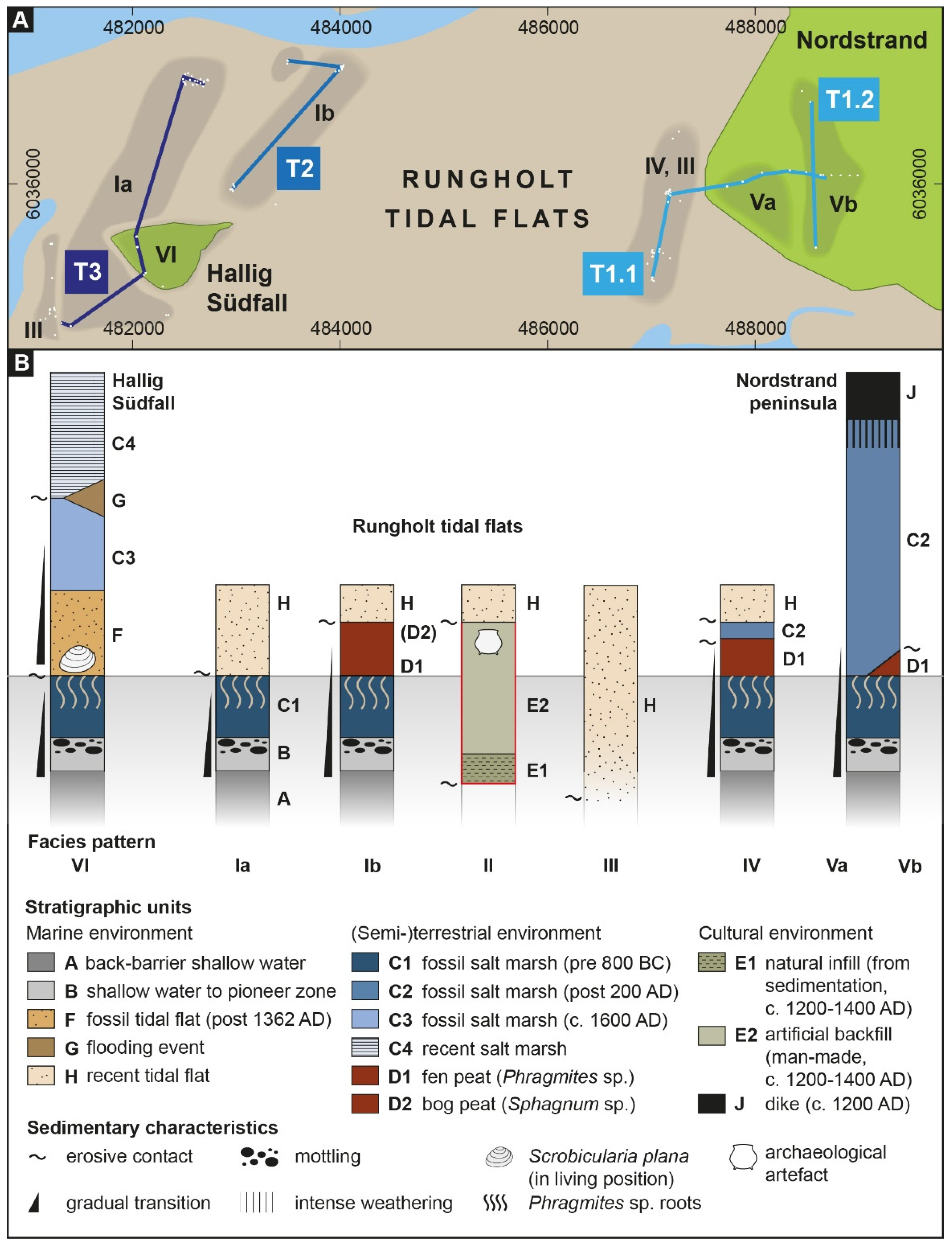
4.1. From Natural Coastal Dynamics
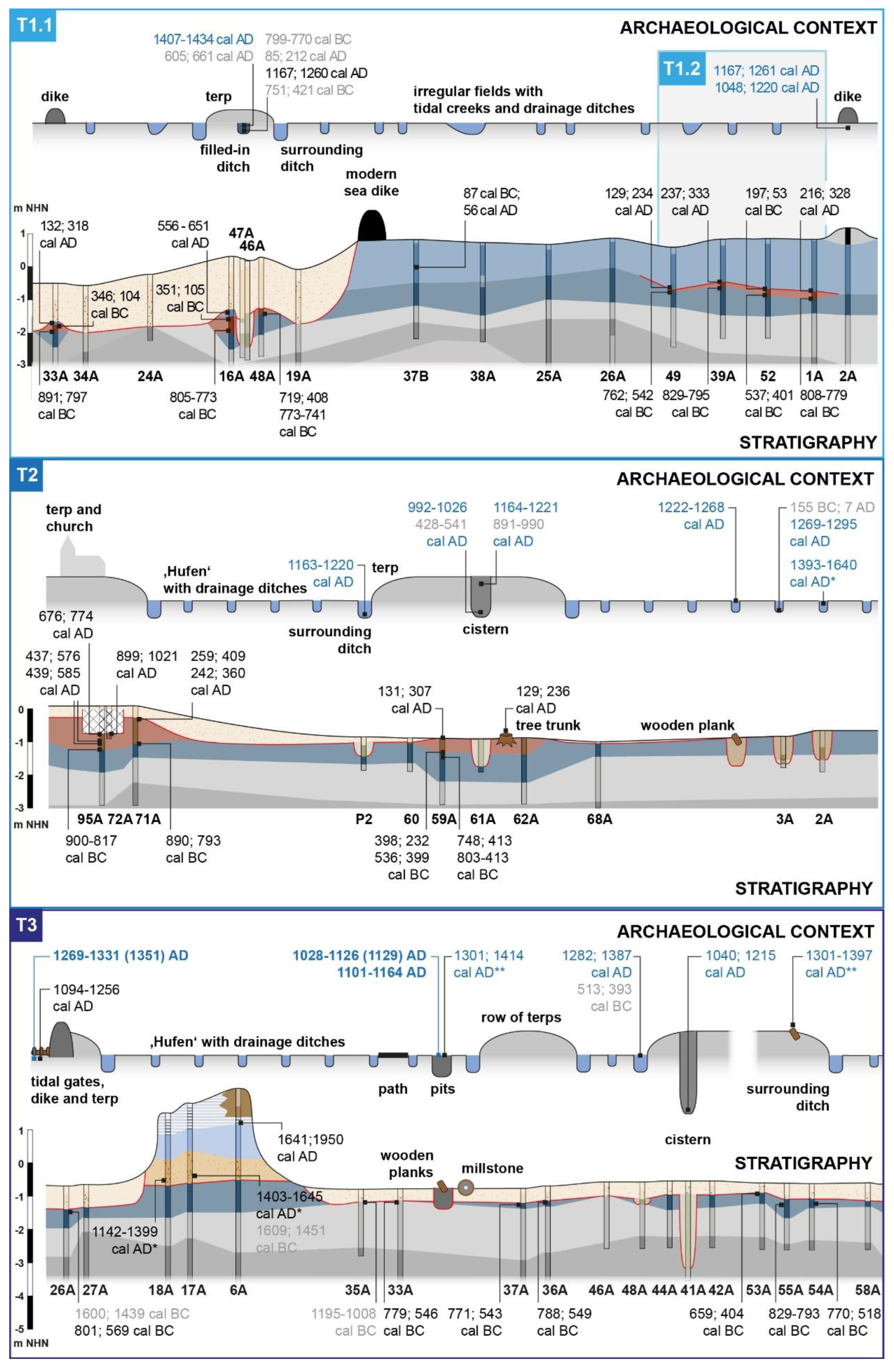
4.2. Towards a Cultural Landscape
4.3. Storm Surges and the Formation of Tidal Flats
5. Discussion
Supplementary Materials
Author Contributions
Funding
Data Availability Statement
Acknowledgments
Conflicts of Interest
References
- Behre, K.-E. New Holocene sea-level curve for the southern North Sea. Boreas 2007, 36, 82–102. [Google Scholar] [CrossRef]
- Bakker, M. The nature and dynamics of pre-Roman Iron Age and Roman Iron Age reclamation settlements in the (former) peat and clay-on-peat area of Friesland (The Netherlands). J. Wetl. Archaeol. 2022, 22, 7–29. [Google Scholar] [CrossRef]
- Bakker, M.; de Langen, G. Peat reclamations of the pre-Roman Iron Age and Roman Iron Age: Drainage ditch systems and settlement patterns in the province of Friesland, the Netherlands. Palaeohistoria 2023, 63, 57–145. [Google Scholar] [CrossRef]
- UNESCO (United Nations Educational, Scientific and Cultural Organisation) 33 COM 8B.4—Decision. Available online: https://whc.unesco.org/en/decisions/1946/ (accessed on 5 November 2024).
- Bazelmans, J.; Meier, D.; Nieuwhof, A.; Spek, T.; Vos, P. Understanding the cultural historical value of the Wadden Sea region. The co-evolution of environment and society in the Wadden Sea area in the Holocene up until early modern times (11,700 BC–1800 AD): An outline. Ocean. Coast. Manag. 2012, 68, 114–126. [Google Scholar] [CrossRef]
- Vollmer, M.; Guldberg, M.; Maluck, M.; van Marrewijk, D.; Schlicksbier, G. Landscape and Cultural Heritage in the Wadden Sea Region—Project Report. In Wadden Sea Ecosystem No. 12; Common Wadden Sea Secretariat: Wilhelmshaven, Germany, 2001; p. 336. [Google Scholar]
- Nieuwhof, A.; Jöns, H.; de Langen, G.; Nicolay, J.; Siegmüller, A. Leben mit dem Meer: Terpen, Wierden und Wurten/Leven met de zee: Terpen, wierden en wurten. In Land der Entdeckungen. Die Archäologie des Friesischen Küstenraums/Land van Ontdekkingen. de Archeologie van het Friese Kustgebied; Nieuwhof, A., Nowak-Klimscha, K., Reimann, H., Eds.; Ostfriesische Landschaftliche Verlags- und Vertriebsgesellschaft mbH: Aurich, Germany, 2013; pp. 146–155. ISBN 978-3-940601-16-2. [Google Scholar]
- Nieuwhof, A.; Bakker, M.; Knol, E.; de Langen, G.J.; Nicolay, J.A.W.; Postma, D.; Schepers, M.; Varwijk, T.W.; Vos, P.C. Adapting to the sea: Human habitation in the coastal area of the northern Netherlands before medieval dike building. Ocean. Coast. Manag. 2019, 173, 77–89. [Google Scholar] [CrossRef]
- Pierik, H.J. Landscape changes and human–landscape interaction during the first millennium AD in The Netherlands. Neth. J. Geosci. 2021, 100, e11. [Google Scholar] [CrossRef]
- Kühn, H.J.; Panten, A. Der Frühe Deichbau in Nordfriesland: Archäologisch-Historische Untersuchungen, 2nd ed.; Nordfriisk Inst: Bräist/Bredstedt, Germany, 1995; ISBN 978-3-88007-158-2. [Google Scholar]
- Behre, K.-E. Landscape development and occupation history along the southern North Sea coast. In Climate Development and History of the North Atlantic Realm: With 16 Tables; Wefer, G., Berger, W.H., Behre, K.-E., Jansen, E., Eds.; Springer: Berlin/Heidelberg, Germany, 2002; pp. 299–312. ISBN 978-3-540-43201-2. [Google Scholar]
- Knottnerus, O.S. History of human settlement, cultural change and interference with the marine environment. Helgol. Mar. Res. 2005, 59, 2–8. [Google Scholar] [CrossRef]
- Jensen, J.; Müller-Navarra, S.H. Storm surges on the German coast. Küste-Arch. Forsch. Tech. Nord. Ostsee 2008, 74, 92–124. [Google Scholar]
- Newig, J.; Kelletat, D. The North Sea Tsunami of 5 June 1858. J. Coast. Res. 2011, 276, 931–941. [Google Scholar] [CrossRef]
- Newig, J. Historische „Seebären“/Meteotsunamis an den deutschen Küsten—Mit einem Schwerpunkt Sylt. In Aktuelle Küstenforschung an der Nordsee; Tillmann, T., Ed.; Coastline Reports EUCC: Wilhelmshaven, Germany, 2015; Volume 25, pp. 87–103. ISBN 978-3-939206-18-7. [Google Scholar]
- Lamb, H.H. Historic Storms of the North Sea, British Isles, and Northwest Europe; Cambridge University Press: Cambridge, UK, 1991; p. 204. ISBN 978-0-521-37522-1. [Google Scholar]
- Behre, K.-E. Landschaftsgeschichte Norddeutschlands: Umwelt und Siedlung von der Steinzeit bis zur Gegenwart; Wachholtz: Neumünster, Germany, 2008; p. 308. ISBN 978-3-529-02499-3. [Google Scholar]
- Fruergaard, M.; Andersen, T.J.; Johannessen, P.N.; Nielsen, L.H.; Pejrup, M. Major coastal impact induced by a 1000-year storm event. Sci. Rep. 2013, 3, 1051. [Google Scholar] [CrossRef]
- Stewart, H.; Bradwell, T.; Bullard, J.; Davies, S.J.; Golledge, N.; McCulloch, R.D. 8000 years of North Atlantic storminess reconstructed from a Scottish peat record: Implications for Holocene atmospheric circulation patterns in Western Europe. J. Quat. Sci. 2017, 32, 1075–1084. [Google Scholar] [CrossRef]
- Hadler, H.; Vött, A.; Willershäuser, T.; Wilken, D.; Blankenfeldt, R.; Carnap–Bornheim, C.; Emde, K.; Fischer, P.; Ickerodt, U.; Klooß, S.; et al. Automated facies identification by Direct Push–based sensing methods (CPT, HPT) and multivariate linear discriminant analysis to decipher geomorphological changes and storm surge impact on a medieval coastal landscape. Earth Surf. Process. Landf. 2021, 46, 3228–3251. [Google Scholar] [CrossRef]
- Hess, K.; Engel, M.; Patel, T.; Vakhrameeva, P.; Koutsodendris, A.; Klemt, E.; Hansteen, T.H.; Kempf, P.; Dawson, S.; Schön, I.; et al. A 1500-year record of North Atlantic storm flooding from lacustrine sediments, Shetland Islands (UK). J. Quat. Sci. 2024, 39, 37–53. [Google Scholar] [CrossRef]
- Petersen, M.; Rohde, H. Sturmflut. Die Großen Fluten an den Küsten Schleswig-Holsteins und in der Elbe, 3rd ed.; Wachholtz Verlag: Neumünster, Germany, 1977; p. 148. ISBN 3-529-06163-8. [Google Scholar]
- Ehlers, J. Die Nordsee: Vom Wattenmeer zum Nordatlantik; Wissenschaftliche Buchgesellschaft: Darmstadt, Germany, 2008; p. 176. ISBN 978-3-89678-638-8. [Google Scholar]
- FWU—Forschungsinstitut Wasser und Umwelt, Universität Siegen Kleine Dokumentation Historischer Sturmfluten. 2019. Available online: https://www.bau.uni-siegen.de/fwu/wb/publikationen/sturmflutarchiv/ (accessed on 6 November 2024).
- van Popta, Y.T.; Cohen, K.M.; Vos, P.C.; Spek, T.H. Reconstructing medieval eroded landscapes of the North-Eastern Zuyder Zee (the Netherlands): A refined palaeogeographical time series of the Noordoostpolder between a.d. 1100 and 1400. Landsc. Hist. 2020, 41, 27–56. [Google Scholar] [CrossRef]
- Streif, H. Sedimentary record of Pleistocene and Holocene marine inundations along the North Sea coast of Lower Saxony, Germany. Quat. Int. 2004, 112, 3–28. [Google Scholar] [CrossRef]
- Newig, J. Nordfrieslands Küste zwischen Landgewinn und Landverlust. Geogr. Rundsch. 2014, 66, 4–13. [Google Scholar]
- Trouet, V.; Esper, J.; Graham, N.E.; Baker, A.; Scourse, J.D.; Frank, D.C. Persistent Positive North Atlantic Oscillation Mode Dominated the Medieval Climate Anomaly. Science 2009, 324, 78–80. [Google Scholar] [CrossRef]
- Trouet, V.; Scourse, J.D.; Raible, C.C. North Atlantic storminess and Atlantic Meridional Overturning Circulation during the last Millennium: Reconciling contradictory proxy records of NAO variability. Glob. Planet. Chang. 2012, 84, 48–55. [Google Scholar] [CrossRef]
- Baker, A.; Hellstrom, J.C.; Kelly, B.F.J.; Mariethoz, G.; Trouet, V.A. Composite annual-resolution stalagmite record of North Atlantic climate over the last three millennia. Sci. Rep. 2015, 5, 10307. [Google Scholar] [CrossRef]
- Orme, L.C.; Reinhardt, L.; Jones, R.T.; Charman, D.J.; Barkwith, A.; Ellis, M.A. Aeolian sediment reconstructions from the Scottish Outer Hebrides: Late Holocene storminess and the role of the North Atlantic Oscillation. Quat. Sci. Rev. 2016, 132, 15–25. [Google Scholar] [CrossRef]
- Meeker, L.D.; Mayewski, P.A. A 1400-year high-resolution record of atmospheric circulation over the North Atlantic and Asia. Holocene 2002, 12, 257–266. [Google Scholar] [CrossRef]
- Hoffmann, D. Das Küstenholozän im Einzugsbereich der Norderhever, Nordfriesland. In Das Norderhever-Projekt 1. Landschaftsentwicklung und Besiedlungsgeschichte im Einzugsgebiet der Norderhever; Müller-Wille, M., Higelke, B., Hoffmann, D., Menke, B., Brande, A., Bokelmann, K., Saggau, H.E., Kühn, H.J., Eds.; Karl Wachholtz Verlag: Neumünster, Germany, 1988; pp. 51–115. [Google Scholar]
- Karle, M.; Bungenstock, F.; Wehrmann, A. Holocene coastal landscape development in response to rising sea level in the Central Wadden Sea Coastal Region. Neth. J. Geosci. 2021, 100, e12. [Google Scholar] [CrossRef]
- Hadler, H.; Wilken, D.; Bäumler, S.; Fischer, P.; Rabbel, W.; Willershäuser, T.; Wunderlich, T.; Vött, A. The Trendermarsch polder (North Frisia, Germany)—Geophysical and geoarchaeological investigations of an anthropogenic medieval coastal landscape and its vulnerability against natural hazards. Geomorphology 2022, 418, 108461. [Google Scholar] [CrossRef]
- Scheder, J.; Bungenstock, F.; Haynert, K.; Pint, A.; Schlütz, F.; Frenzel, P.; Wehrmann, A.; Brückner, H.; Engel, M. Insights into Holocene relative sea-level changes in the southern North Sea using an improved microfauna-based transfer function. J. Quat. Sci. 2022, 37, 71–85. [Google Scholar] [CrossRef]
- Hoffmann, D. Landschafts- und Siedlungsgeschichte im Bereich der heutigen Marscheninseln und Watten Nordfrieslands. A. Geologische Untersuchungen. In Siedlungsforschung. Archäologie-Geschichte-Geographie Band 2; Fehn, K., Brandt, K., Denecke, D., Irsigler, F., Janssen, W., Krings, W., Lüning, J., Müller-Wille, M., Nitz, H.-J., Oberbeck, G., et al., Eds.; Verlag Siedlungsforschung: Bonn, Germany, 1984; pp. 165–172. [Google Scholar]
- Soens, T. Threatened by the Sea, Condemned by Man? Flood Risk and Environmental Inequalities along the North Sea Coast, 1200-1800. In Environmental and Social Justice in the City: Historical Perspectives; Massard-Guilbaud, G., Rodger, R., Eds.; The White Horse Press: Cheshire, UK, 2011; pp. 91–111. ISBN 978-1-912186-33-4. [Google Scholar]
- Soens, T. The origins of the Western Scheldt. Environmental transformation, storm surges and human agency in the Flemish coastal plain (1250–1600). In Landscapes or Seascapes? The History of the Coastal Environment in the North Sea Area Reconsidered; Thoen, E., Borger, G.J., De Kraker, A.M.J., Soens, T., Tys, D., Vervaet, L., Weerts, H.J.T., Eds.; Brepols Publishers: Turnhout, Belgium, 2013; pp. 287–312. ISBN 978-2-503-54695-7. [Google Scholar]
- Knottnerus, O.S. Reclamations and submerged lands in the Ems River estuary (900–1500). In Landscape or Seascape? The History of the Coastal Environment in the North Sea Area Reconsidered; Thoen, E., Borger, G.J., De Kraker, A.M.J., Soens, T., Tys, D., Vervaet, L., Weerts, H.J.T., Eds.; Brepols Publishers: Turnhout, Belgium, 2013; Volume 13, pp. 241–266. ISBN 978-2-503-54058-0. [Google Scholar]
- de Langen, G. De gang naar een ander landschap. De ontginning van de (klei-op-)veengebieden in Fryslân gedurende de late ijzertijd, Romeinse tijd en middeleeuwen (van ca. 200 v. Chr. tot ca. 1200 na Chr.). In Gevormd en Omgevormd Landschap. Van Prehistorie tot Middeleeuwen; Niekus, M.J.L.T.H., van der Zee, S., Looijenga, T., Kiestra, F., Eds.; Drents Prehistorische Vereniging: Assen, The Netherlands, 2011; pp. 70–97. [Google Scholar]
- Vos, P.C.; Knol, E. Holocene landscape reconstruction of the Wadden Sea area between Marsdiep and Weser: Explanation of the coastal evolution and visualisation of the landscape development of the northern Netherlands and Niedersachsen in five palaeogeographical maps from 500 BC to present. Neth. J. Geosci. 2015, 94, 157–183. [Google Scholar] [CrossRef]
- Knol, E.; Vos, P.C. Lauwerzee. In Fragmenten uit de Rijke Wereld van de Archeologie: Opgedragen aan Ernst Taayke Bij Zijn Afscheid als Beheerder van het Noordelijk Archeologisch Depot in Nuis; Nieuwhof, A., Knol, E., Schokker, J., Arnoldussen, S., Van den Broeke, P.W., Burie-Gotink, A., Taayke, E., Eds.; Jaarverslagen van de Vereniging voor Terpenonderzoek: Groningen, The Netherlands, 2018; pp. 157–168. ISBN 978-90-811714-9-6. [Google Scholar]
- Marschallek, K.H. Die Salzgewinnung an der friesischen Nordseeküste. In Probleme der Küstenforschung im Südlichen Nordseegebiet; Isensee Verlag: Oldenburg, Germany, 1974; Volume 10, pp. 127–146. [Google Scholar]
- Siegmüller, A.; Bungenstock, F. Salztorfabbau im Jadebusengebiet. Prospektion von anthropogenen Landabsenkungen und ihren Folgen. Nachrichten Aus Niedersachs. Urgesch. 2010, 79, 201–220. [Google Scholar] [CrossRef]
- Majchczack, B.S.; Blankenfeldt, R.; Bienen-Scholt, D.; Hadler, H.; Jürgens, F.; Klooß, S.; Reiß, A.; Wilken, D.; von Carnap-Bornheim, C.; Rabbel, W.; et al. Living on the Halligen tidal islands of North Frisia. Land-use and exploitation of a unique salt marsh landscape in the Middle Ages. In Making Places, Making Lives. Landscape and Settlement in Coastal Wetlands, Proceedings of the 72th Sachsensymposion, Alkmaar, The Netherlands, 9–12 October 2021; Nieuwhof, A., Knol, E., van der Velde, H., Eds.; Uwe Krebs: Wendeburg, Germany, 2024; p. 2024. [Google Scholar]
- Rieken, B. Nordsee ist Mordsee. Sturmfluten und ihre Bedeutung für die Mentalitätsgeschichte der Friesen; Waxmann: Münster, Germany, 2005; p. 456. ISBN 978-3-8309-1499-0. [Google Scholar]
- Fouquet, G.; Zeilinger, G. Katastrophen im Spätmittelalter; von Zabern, P., Ed.; Von Zabern Verlag: Darmstadt, Germany, 2011; p. 172. ISBN 978-3-8053-4362-6. [Google Scholar]
- Bantelmann, A. Die Landschaftsentwicklung im nordfriesischen Küstengebiet. Eine Funktionschronik durch fünf Jahrtausende. Die Küste 1967, 14, 5–99. [Google Scholar]
- Kühn, H.J. Jenseits der Deiche. Archäologie im nordfriesischen Wattenmeer. In Es War Einmal Ein Schiff; von Carnap-Bornheim, C., Radtke, C., Eds.; Marebuchverlag: Hamburg, Germany, 2007; pp. 251–284. ISBN 978-3-86648-053-7. [Google Scholar]
- Hoffmann, D. Holocene landscape development in the marshes of the West Coast of Schleswig-Holstein, Germany. Quat. Int. 2004, 112, 29–36. [Google Scholar] [CrossRef]
- Auge, O. Die Nordfriesischen Utlande und König Waldemar II. der Sieger (Sejr) von Dänemark. In Rungholt. Rätselhaft und Widersprüchlich; Newig, J., Haupenthal, U., Eds.; Husum Druck- und Verlagsgesellschaft: Husum, Germany, 2016; pp. 37–40. ISBN 978-3-89876-824-5. [Google Scholar]
- Meier, D. Man and environment in the marsh area of Schleswig–Holstein from Roman until late Medieval Times. Quat. Int. 2004, 112, 55–69. [Google Scholar] [CrossRef]
- Eversberg, G. Die Rungholtsage. Nord. Kunst-Und Kult. Gesch. Schleswig-Holst. 2005, 74, 113–143. [Google Scholar]
- Ickerodt, U. Was ist Kryptoarchäologie? Von Rungholt und anderen Lost Worlds. In Archäologische Nachrichten aus Schleswig-Holstein; Archäologisches Landesamt Schleswig-Holstein (ALSH), Ed.; Wachholtz Verlag: Kiel, Germany, 2016; Volume 22, pp. 142–149. ISBN 978-3-529-01438-3. [Google Scholar]
- Majchczack, B.S.; Klooß, S.; Hadler, H.; Wilken, D.; Blankenfeldt, R. Mehr als Rungholt. Spurensuche im nordfriesischen Wattenmeer. In Zeitreise unter Wasser. Spektakuläre Entdeckungen zwischen Ostsee und Bodensee; Huber, F., Ed.; Theiss in Herder: Hamburg, Germany, 2021; pp. 116–129. ISBN 978-3-8062-4350-5. [Google Scholar]
- Blankenfeldt, R.; Klooß, S.; Hadler, H.; Majchczack, B.S.; Wilken, D.; Bienen-Scholt, D. Versunkene Landschaften im Nordfriesischen Watt—Das aktuelle RUNGHOLT-Projekt zur Erforschung von Kulturspuren. In Arkæologi i Slesvig Symposium Christianslyst 17.-18.6.2022; Klooß, S., Kruse, P., Lütjens, I., Eds.; Wachholtz Verlag: Haderslev, Danmark, 2023; Volume 19, pp. 59–74. ISBN 978-87-87584-39-5. [Google Scholar]
- Busch, A. Die Entdeckung der letzten Spuren Rungholts. Jahrb. Nord. Für Heimatkunde Heimatliebe 1923, 10, 1–32. [Google Scholar]
- Wilken, D.; Hadler, H.; Wunderlich, T.; Majchczack, B.S.; Schwardt, M.; Fediuk, A.; Fischer, P.; Willershäuser, T.; Klooß, S.; Vött, A.; et al. Lost in the North Sea-Geophysical and geoarchaeological prospection of the Rungholt medieval dyke system (North Frisia, Germany). PLoS ONE 2022, 17, e0265463. [Google Scholar] [CrossRef] [PubMed]
- Wilken, D.; Hadler, H.; Majchczack, B.S.; Blankenfeldt, R.; Auge, O.; Bäumler, S.; Bienen-Scholt, D.; Ickerodt, U.; Klooß, S.; Reiß, A.; et al. The discovery of the church of Rungholt, a landmark for the drowned medieval landscapes of the Wadden Sea World Heritage. Sci. Rep. 2024, 14, 15576. [Google Scholar] [CrossRef]
- Hadler, H.; Vött, A. Der Handelsplatz Rungholt und seine Zerstörung durch die 1. Grote Mandrenke im Jahr 1362. Geogr. Rundsch. 2017, 69, 20–25. [Google Scholar]
- Kühn, H.J. Die archäologischen Funde aus dem Rungholt-Watt. In Rungholt. Rätselhaft und Widersprüchlich; Newig, J., Haupenthal, U., Eds.; Husum Druck- und Verlagsgesellschaft: Husum, Germany, 2016; pp. 125–166. ISBN 978-3-89876-824-5. [Google Scholar]
- Hadler, H.; Wilken, D.; Wunderlich, T.; Fediuk, A.; Fischer, P.; Schwardt, M.; Willershäuser, T.; Rabbel, W.; Vött, A. Drowned by the Grote Mandrenke in 1362: New geo-archaeological research on the late medieval trading centre of Rungholt (North Frisia). In Waddenland Outstanding: History, Landscape and Cultural Heritage of the Wadden Sea Region; Egberts, L., Schroor, M., Eds.; Amsterdam University Press: Amsterdam, The Netherlands, 2018; pp. 239–251. ISBN 978-90-485-3788-4. [Google Scholar]
- Higelke, B. Das Norderhever-Projekt. Beiträge zur Landschafts- und Siedlungsgeschichte der nordfriesischen Marschen und Watten. Besiedlungs- und jüngere Landschaftsgeschichte. Geographische Untersuchungen. Offa—Berichte Mitteilungen Urgesch. Frühgeschichte Mittelalt. 1982, 39, 261–270. [Google Scholar]
- Busch, A. Zur Rekonstruktion der Rungholter Schleusen. Die Heim. 1963, 70, 163–168. [Google Scholar]
- Newig, J.; Haupenthal, U. (Eds.) Rungholt. Rätselhaft und Widersprüchlich; Husum Druck- und Verlagsgesellschaft: Husum, Germany, 2016; p. 174. ISBN 978-3-89876-824-5. [Google Scholar]
- Reiß, A.; Hadler, H.; Wilken, D.; Majchczack, B.S.; Blankenfeldt, R.; Bäumler, S.; Ickerodt, U.; Klooß, S.; Willershäuser, T.; Rabbel, W.; et al. The Trendermarsch sunken in the Wadden Sea (North Frisia, Germany)—Reconstructing a drowned medieval cultural landscape by geoarchaeological and geophysical investigations. EG Quat. Sci. J. 2024. [Google Scholar]
- Reiß, A.; Hadler, H.; Wilken, D.; Majchczack, B.; Blankenfeldt, R.; Ickerodt, U.; Klooß, S.; Rabbel, W.; Willershäuser, T.; Vött, A. Geoarchaeological and geophysical investigations in the tidal flats of the Trendermarsch, Nordstrand (North Frisia, Germany). ZfG-Z. Geomorphol. 2024, epub ahead of printing. [Google Scholar] [CrossRef]
- Ad-hoc. In AG Boden Bodenkundliche Kartieranleitung, 5th ed.; Schweizerbart sciences publisher: Hannover, Germany, 2005; p. 438.
- Schrott, L. Gelände-Arbeitsmethoden in der Geomorphologie. In Einführung in die Geomorphologie; Ahnert, F., Ed.; UTB: Stuttgart, Germany, 2015; pp. 396–413. ISBN 978-3-8383-8627-4. [Google Scholar]
- Hadler, H.; Vött, A.; Newig, J.; Emde, K.; Finkler, C.; Fischer, P.; Willershäuser, T. Geoarchaeological evidence of marshland destruction in the area of Rungholt, present-day Wadden Sea around Hallig Südfall (North Frisia, Germany), by the Grote Mandrenke in 1362 AD. Quat. Int. 2018, 473, 37–54. [Google Scholar] [CrossRef]
- Köhn, M. Korngrößenanalyse vermittels Pipettanalyse. Tonind.-Ztg. 1929, 53, 729–731. [Google Scholar]
- Blume, H.-P.; Stahr, K.; Leinweber, P. Bodenkundliches Praktikum: Eine Einführung in Pedologisches Arbeiten für Ökologen, Land- und Forstwirte, Geo- und Umweltwissenschaftler, 3rd ed.; Spektrum Akademischer Verlag: Heidelberg, Germany, 2011; p. 255. ISBN 978-3-8274-1553-0. [Google Scholar]
- Blott, S.J.; Pye, K. GRADISTAT: A grain size distribution and statistics package for the analysis of unconsolidated sediments. Earth Surf Process. Landf 2001, 26, 1237–1248. [Google Scholar] [CrossRef]
- Schmidt, W.; Scheibner, H. Zur Bestimmung des Gehaltes an organischer Substanz von Torfen und Mudden. Arch. Acker Pflanzenbau Bodenkd. 1988, 32, 423–433. [Google Scholar]
- Barsch, H. Geoökologische Bewertung der Befunde. In Arbeitsmethoden in Physiogeographie und Geoökologie; Barsch, H., Billwitz, K., Bork, H.-R., Eds.; Klett-Perthes: Gotha, Germany, 2000; pp. 451–496. ISBN 978-3-623-00848-6. [Google Scholar]
- Dearing, J.; Hay, K.L.; Baban, S.M.J.; Huddleston, A.S.; Wellington, E.M.H.; Loveland, P.J. Magnetic susceptibility of soil: An evolution of conflicting theories using a national data set. Geophys. J. Int. 1996, 127, 728–734. [Google Scholar] [CrossRef]
- Evans, M.E.; Heller, F. Environmental Magnetism—Principles and Applications of Enviromagnetics; Academic Press: San Diego, CA, USA, 2003; p. 299. ISBN 0-12-243851-5. [Google Scholar]
- Hanesch, M.; Scholger, R. The influence of soil type on the magnetic susceptibility measured throughout soil profiles. Geophys. J. Int. 2005, 161, 50–56. [Google Scholar] [CrossRef]
- Goldberg, P.; Macphail, R.I. Practical and Theoretical Geoarchaeology; Wiley-Blackwell: Hoboken, NJ, USA, 2006; p. 463. ISBN 9781118688182. [Google Scholar]
- Mann, S.; Sparks, N.H.C.; Frankel, R.B.; Bazylinski, D.A.; Jannasch, H.W. Biomineralization of ferrimagnetic greigite (Fe3S4) and iron pyrite (FeS2) in a magnetotactic bacterium. Nature 1990, 343, 258–261. [Google Scholar] [CrossRef]
- Heywood, B.R.; Bazylinski, D.A.; Garratt-Reed, A.; Mann, S.; Frankel, R.B. Controlled biosynthesis of greigite (Fe3S4) in magnetotactic bacteria. Naturwissenschaften 1990, 77, 536–538. [Google Scholar] [CrossRef]
- Hilton, J. Greigite and the magnetic properties of sediments. Limnol. Oceanogr. 1990, 35, 509–520. [Google Scholar] [CrossRef]
- Stanjek, H.; Fassbinder, J.W.E.; Vali, H.; Wägele, H.; Graf, W. Evidence of biogenic greigite (ferrimagnetic Fe3S4) in soil. Eur. J. Soil Sci. 1994, 45, 97–103. [Google Scholar] [CrossRef]
- Wheeler, A.J.; Oldfield, F.; Orford, J.D. Depositional and Post–Depositional controls on magnetic signals from saltmarshes on the north–west coast of Ireland. Sedimentology 1999, 46, 545–558. [Google Scholar] [CrossRef]
- EPA—United States Environmental Protection Agency. Field Portable X-Ray Fluorescence Spectrometry for the Determination of Elemental Concentrations in Soil and Sediment. Available online: https://www.epa.gov/sites/default/files/2015-12/documents/6200.pdf (accessed on 11 November 2024).
- Chagué-Goff, C.; Goff, J.; Wong, H.K.Y.; Cisternas, M. Insights from geochemistry and diatoms to characterise a tsunami’s deposit and maximum inundation limit. Mar. Geol. 2015, 359, 22–34. [Google Scholar] [CrossRef]
- Chagué-Goff, C.; Szczuciński, W.; Shinozaki, T. Applications of geochemistry in tsunami research: A review. Earth-Sci. Rev. 2017, 165, 203–244. [Google Scholar] [CrossRef]
- Judd, K.; Chagué-Goff, C.; Goff, J.; Gadd, P.; Zawadzki, A.; Fierro, D. Multi-proxy evidence for small historical tsunamis leaving little or no sedimentary record. Mar. Geol. 2017, 385, 204–215. [Google Scholar] [CrossRef]
- Finkler, C.; Fischer, P.; Baika, K.; Rigakou, D.; Metallinou, G.; Hadler, H.; Vött, A. Tracing the Alkinoos Harbor of Ancient Kerkyra, Greece, and reconstructing its paleotsunami history. Geoarchaeology 2018, 33, 24–42. [Google Scholar] [CrossRef]
- Scott, D.B.; Hermelin, J.O.R. A Device for Precision Splitting of Micropaleontological Samples in Liquid Suspension. J. Paleontol. 1993, 67, 151–154. [Google Scholar] [CrossRef]
- Murray, J.W. An Atlas of British Recent Foraminiferids; Heinemann Educational Books: London, UK, 1971; ISBN 0-435-62430-X. [Google Scholar]
- Horton, B.P.; Edwards, R.J. Quantifying Holocene Sea Level Change Using Intertidal Foraminifera: Lessons from the British Isles. Dep. Pap. (EES) 2006, 40, 1–97. [Google Scholar] [CrossRef]
- Sen Gupta, B.K. Modern Foraminifera; Kluwer Academic Publishers: Dordrecht, The Netherlands, 1999; p. 371. ISBN 978-1-4020-0598-5. [Google Scholar]
- Scott, D.B.; Medioli, F.S.; Schafer, C.T. Monitoring in Coastal Environments Using Foraminifera and Thecamoebian Indicators; Cambridge University Press: Cambridge, UK, 2001; p. 177. ISBN 978-0-521-56173-0. [Google Scholar]
- Murray, J.W. Ecology and Applications of Benthic Foraminifera; Cambridge University Press: Cambridge, UK, 2006; p. 426. ISBN 978-0-511-53552-9. [Google Scholar]
- Lehmann, G. Vorkommen, Populationsentwicklung, Ursache fleckenhafter Besiedlung und Fortpflanzungsbiologie von Foraminiferen in Salzwiesen und Flachwasser der Nord- und Ostseeküste Schleswig—Holsteins. Ph.D. Thesis, MACAU Christian-Albrechts-Universität zu Kiel, Kiel, Germany, 2000. [Google Scholar]
- Müller-Navarra, K.; Milker, Y.; Schmiedl, G. Natural and anthropogenic influence on the distribution of salt marsh foraminifera in the Bay of Tümlau, German North Sea. J. Foraminifer. Res. 2016, 46, 61–74. [Google Scholar] [CrossRef]
- Müller-Navarra, K.; Milker, Y.; Bunzel, D.; Lindhorst, S.; Friedrich, J.; Arz, H.; Schmiedl, G. Evolution of a salt marsh in the southeastern North Sea region—Anthropogenic and natural Forcing. Estuar. Coast. Shelf Sci. 2019, 218, 268–277. [Google Scholar] [CrossRef]
- Müller-Navarra, K.; Milker, Y.; Schmiedl, G. Applicability of transfer functions for relative sea-level reconstructions in the southern North Sea coastal region based on salt-marsh foraminifera. Mar. Micropaleontol. 2017, 135, 15–31. [Google Scholar] [CrossRef]
- Athersuch, J.; Horne, D.J.; Whittaker, J.E. Marine and Brackish Water Ostracods (Superfamilies Cypridacea and Cytheracea). Keys and Notes for the Identification of the Species. In Synopses of the British Fauna (New Series); E.J. Brill Publishing Company: Leiden, The Netherlands, 1989; p. 359. ISBN 90-04-09079-7. [Google Scholar]
- Frenzel, P.; Keyser, D.; Viehberg, F. An illustrated key and (palaeo)ecological primer for Postglacial to Recent Ostracoda (Crustacea) of the Baltic Sea. Boreas 2010, 39, 567–575. [Google Scholar] [CrossRef]
- Willmann, R. Muscheln und Schnecken der Nord- und Ostsee; Neumann-Neudamm JNN-Naturführer: Melsungen, Germany, 1989; p. 310. ISBN 978-3-7888-0555-5. [Google Scholar]
- Enters, D.; Haynert, K.; Wehrmann, A.; Freund, H.; Schlütz, F. A new ΔR value for the southern North Sea and its application in coastal research. Neth. J. Geosci. 2021, 100, e1. [Google Scholar] [CrossRef]
- Bungenstock, F.; Weerts, H.J.T. The high-resolution Holocene sea-level curve for Northwest Germany: Global Signals, local effects or data-artefacts? Int. J. Earth Sci. 2010, 99, 1687–1706. [Google Scholar] [CrossRef]
- Nitz, H.-J. Die mittelalterliche und frühneuzeitliche Besiedlung von Marsch und Moor zwischen Ems und Weser. In Siedlungsforschung. Archäologie-Geschichte-Geographie, Band 2; Fehn, K., Brandt, K., Denecke, D., Irsigler, F., Janssen, W., Krings, W., Lüning, J., Müller-Wille, M., Nitz, H.-J., Oberbeck, G., et al., Eds.; Siedlungsforschung: Bonn, Germany, 1984; pp. 43–76. [Google Scholar]
- Müller-Wille, M. Mittelalterliche und frühneuzeitliche Siedlungsentwicklung in Moor- und Marschengebieten. In Siedlungsforschung. Archäologie-Geschichte-Geographie, Band 2; Fehn, K., Brandt, K., Denecke, D., Irsigler, F., Janssen, W., Krings, W., Lüning, J., Müller-Wille, M., Nitz, H.-J., Oberbeck, G., et al., Eds.; Siedlungsforschung: Bonn, Germany, 1984; pp. 7–42. [Google Scholar]
- Panten, A. Der Reichtum der Rungholter: Sage oder Wirklichkeit? In Rungholt. Rätselhaft & Widersprüchlich; Newig, J., Haupenthal, U., Eds.; Husum Druck- und Verlagsgesellschaft: Husum, Germany, 2016; pp. 41–45. ISBN 978-3-89876-824-5. [Google Scholar]
- Wegener, T.H. Vorläufige Mitteilung über Studien im nordfriesischen Wattgebiet. Cent. Mineral. Geol. Paläontologie 1931, 58, 193–201. [Google Scholar]
- Müller, F.; Fischer, O. Das Wasserwesen an der Schleswig-Holsteinischen Nordseeküste, Teil II: Die Inseln: Folge 2: Alt-Nordstrand; Verlag Dietrich Reimer: Berlin, Germany, 1936; p. 224. [Google Scholar]
- Hadler, H.; Vött, A. Das Rungholt-Watt im Fokus aktueller geoarchäologischer Forschungen. In Rungholt. Rätselhaft und Widersprüchlich; Newig, J., Haupenthal, U., Eds.; Husum Druck- und Verlagsgesellschaft: Husum, Germany, 2016; pp. 118–120. ISBN 978-3-89876-824-5. [Google Scholar]
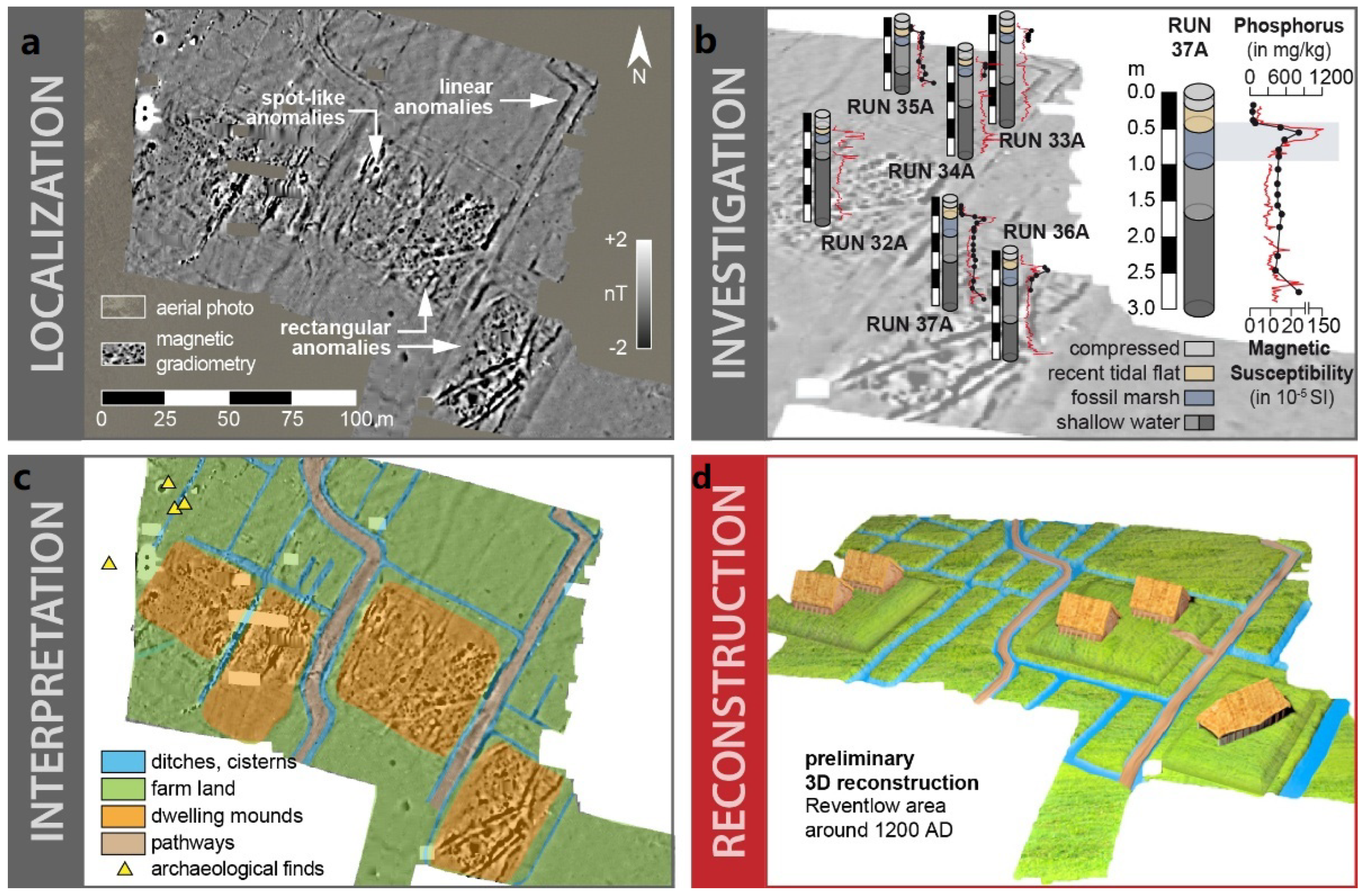
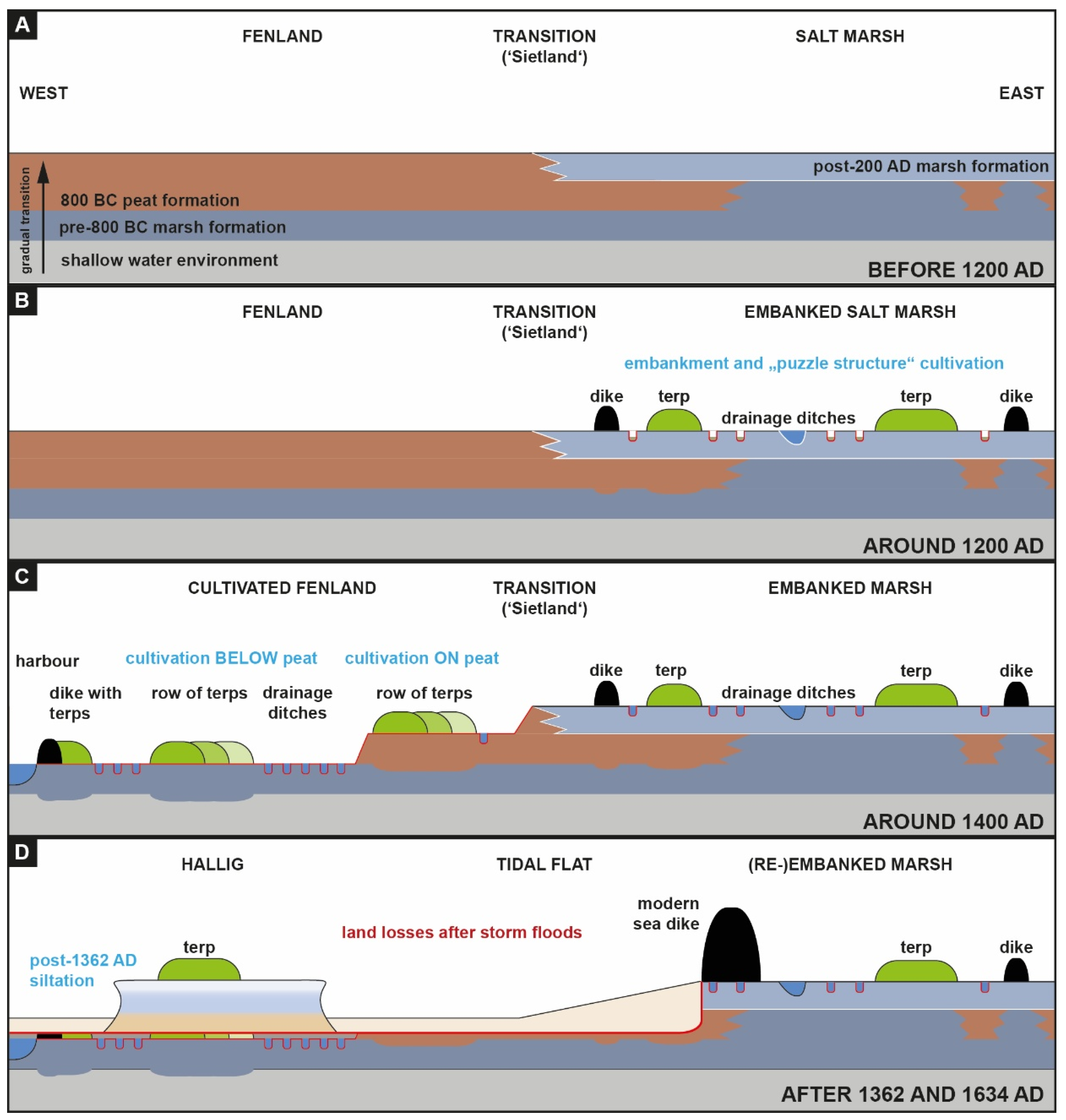
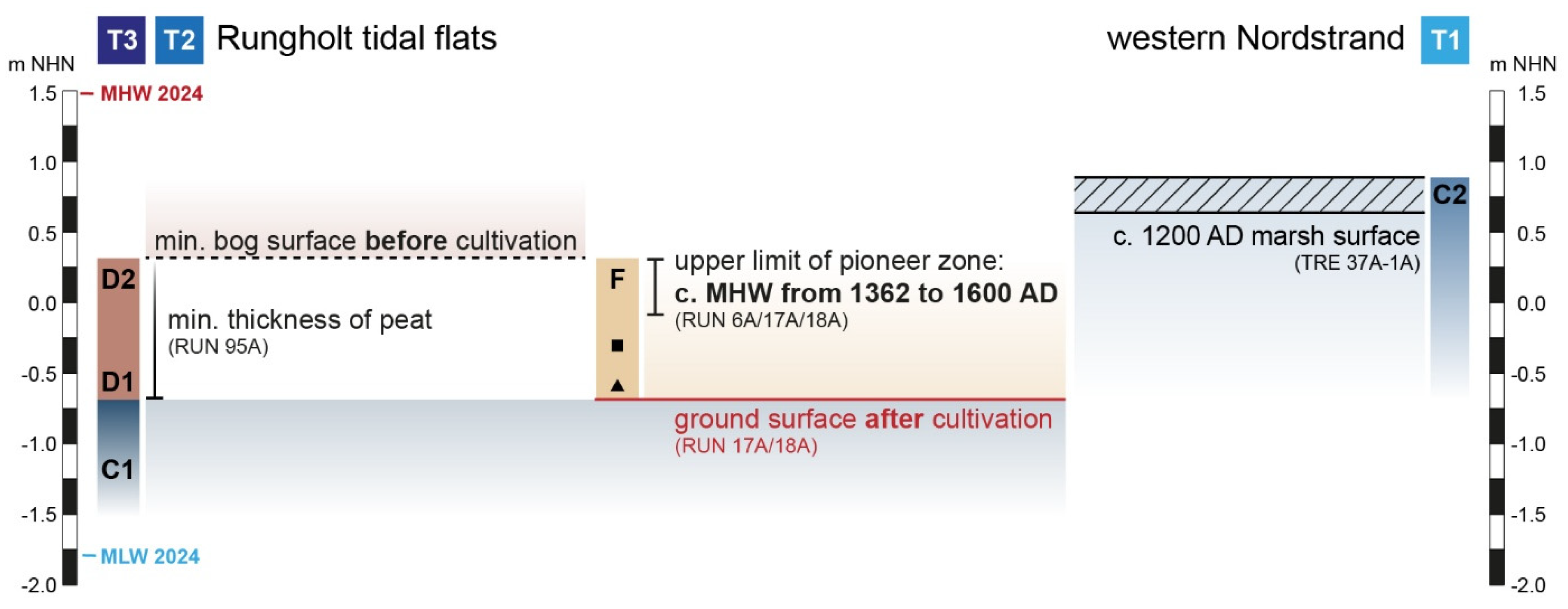
Disclaimer/Publisher’s Note: The statements, opinions and data contained in all publications are solely those of the individual author(s) and contributor(s) and not of MDPI and/or the editor(s). MDPI and/or the editor(s) disclaim responsibility for any injury to people or property resulting from any ideas, methods, instructions or products referred to in the content. |
© 2024 by the authors. Licensee MDPI, Basel, Switzerland. This article is an open access article distributed under the terms and conditions of the Creative Commons Attribution (CC BY) license (https://creativecommons.org/licenses/by/4.0/).
Share and Cite
Hadler, H.; Reiß, A.; Willershäuser, T.; Wilken, D.; Blankenfeldt, R.; Majchczack, B.; Klooß, S.; Ickerodt, U.; Vött, A. Medieval Overexploitation of Peat Triggered Large-Scale Drowning and Permanent Land Loss in Coastal North Frisia (Wadden Sea Region, Germany). Geosciences 2025, 15, 1. https://doi.org/10.3390/geosciences15010001
Hadler H, Reiß A, Willershäuser T, Wilken D, Blankenfeldt R, Majchczack B, Klooß S, Ickerodt U, Vött A. Medieval Overexploitation of Peat Triggered Large-Scale Drowning and Permanent Land Loss in Coastal North Frisia (Wadden Sea Region, Germany). Geosciences. 2025; 15(1):1. https://doi.org/10.3390/geosciences15010001
Chicago/Turabian StyleHadler, Hanna, Antonia Reiß, Timo Willershäuser, Dennis Wilken, Ruth Blankenfeldt, Bente Majchczack, Stefanie Klooß, Ulf Ickerodt, and Andreas Vött. 2025. "Medieval Overexploitation of Peat Triggered Large-Scale Drowning and Permanent Land Loss in Coastal North Frisia (Wadden Sea Region, Germany)" Geosciences 15, no. 1: 1. https://doi.org/10.3390/geosciences15010001
APA StyleHadler, H., Reiß, A., Willershäuser, T., Wilken, D., Blankenfeldt, R., Majchczack, B., Klooß, S., Ickerodt, U., & Vött, A. (2025). Medieval Overexploitation of Peat Triggered Large-Scale Drowning and Permanent Land Loss in Coastal North Frisia (Wadden Sea Region, Germany). Geosciences, 15(1), 1. https://doi.org/10.3390/geosciences15010001






